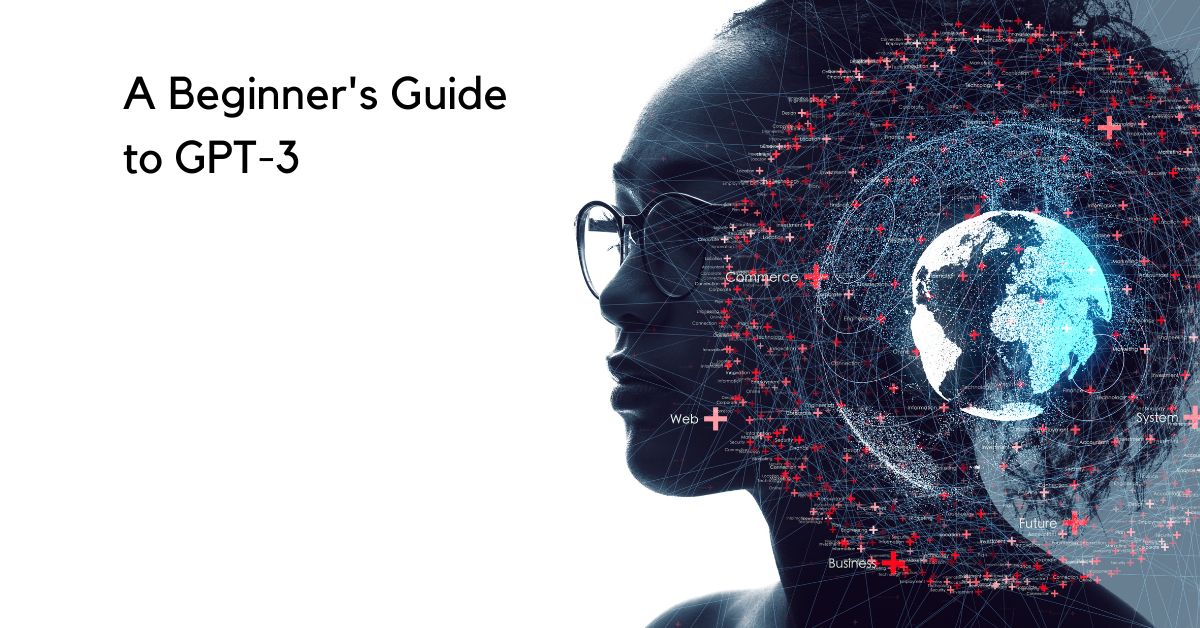A Beginner’s Guide to GPT-3
Have you ever experienced writer’s block? Wished your computer could understand you? Now with natural language processing, a form of artificial intelligence, we’ve got a number of AI writing tools to help us out.
One of the most powerful and well-known algorithms for AI writing is GPT-3. In this article, we’ll explain more about GPT-3 and, hopefully, you’ll walk away with a better understanding of it.
What is GPT-3?
You may have heard mention of something called GPT-3, but can’t articulate what it means. GPT-3 is a set of machine learning models that understands and generates natural language. GPT-3 stands for Generative Pre-trained Transformer third generation. With this machine-generated text generator created by OpenAI, you can generate large volumes of relevant, sophisticated text using only a small amount of input text.
With over 175 billion machine learning parameters, GPT -3’s deep learning neural network is one of the world’s largest neural networks. Compare that with Microsoft’s Turing NLG model, which had 17 billion parameters. Before GPT-3, that was the largest trained language model. As of early 2021, GPT-3 is the largest neural network ever created. Because of this, GPT-3 does a better job of producing text that seems to be written by a human than any previous model.
Who created GPT-3?
On June 11, 2020, OpenAI released the API to the GPT-3 AI writing model for everyone. It was the biggest update since the release of previous predecessors, GPT-2 and GPT-1. It contains a much deeper understanding of language and text than the GPT- 2.0 model. Language translation, question answering, and text classification are just a few of the tasks that GPT-3 is capable of.
OpenAI aims to promote and develop safe artificial intelligence for the benefit of humanity. The founders envision OpenAI as an extension of the human will to benefit humanity.
GPT-3 is a collection of neural network machine learning models that generate text using data pulled from the internet and little user input.
Most AI copywriting tools use GPT-3 as their underlying text generator.
How Does GPT-3 Work?
Imagine teaching a language to a child. Children tend to learn language from “the bottom up” where they test out nonsense words to form a sentence. An adult will correct them and tell them the correct version of the word to use.
GPT-3 operates in the same way. It fills in the blanks with words to create a sentence and continually adjusting the words until its programming gives it the green light.
Within the world of artificial intelligence, GPT-3 lives within the world of natural language processing (NLP).
Basics of Natural Language Processing
Natural language processing (NLP) focuses on using natural human language within the context of computing.
Many different types of language processing tasks can fall within NLP including:
- Sentiment analysis
- Speech recognition
- Machine translation
- Text generation
- Text summarization
Human language is incredibly nuanced and complex. There are often many words that sound similar or have different meanings depending on the context. This can make it difficult for people to communicate effectively, especially if they are unfamiliar with the language. For example, the word “right” can mean both correct and opposite of left, while the word “left” can mean both departed and the opposite of right. Similarly, the word “fair” can mean both just and light-colored.
These examples highlight how important it is to be aware of the various meanings of words when communicating with others. Without this understanding, there is a risk of miscommunication and misunderstanding.
For a native English speaker, understanding the above different word meanings and contexts seems basic. However, it’s very difficult for a machine to understand this.
The way to teach a machine is through programming it.
What is GPT-3 doing behind the scenes?
While GPT-3 is an NLP system designed for general use, it does one basic thing: it predicts what comes next, based on the text it is given.
How does the programming know what’s right or wrong? Intricate parameters and rules govern the technology. Moreover, it’s trained on over 45 TB of data from the internet to learn about the patterns people use.
If GPT-3 were trained on thousands of videos showing people walking around New York City, it would be able to describe photos from New York City as “a person walking down the street.”
Based on the pre-training of a huge amount of text, GPT-3 is the third version of a model that generates AI-based text.
The system analyzes user input and creates the most likely output by analyzing the language. The model produces high-quality output text that feels like human output, even without much additional tuning or training.
Examples of GPT-3 Tools
Using the GPT-3 API tools effectively is not an easy task. It requires a lot of time and effort to learn how to use these tools properly. However, anyone can sign up on OpenAI’s website to get access to it.
The reason why most people use GPT-3 AI writing is because it allows you to create deep learning models without having to train your own language models, which takes up a huge amount of computational resources.A wide range of use cases can get solved with GPT-3. On top of GPT-3 are already many innovative solutions, including content creation, copywriting, autocomplete, and chatbots. Innovators of well-established products have used GPT-3 to create exciting solutions. Every day, new types of solutions are emerging based on GPT-3 technology.
Here are some examples how GPT-3 is used.
Case Study #1: Copy.ai
Since GPT-3 is all about language processing, let’s look at a writing scenario, I picked Copy.ai because it’s an excellent GPT-3 based tool and has been on the market for a good amount of time Copy AI can distinguish between marketing copy, slogans, and even catchy headlines as content intent. When creating content for businesses or websites, Copy.ai can be a great way to save time and money for busy marketers and business owners.
Copy.ai Use Cases
Blog title
It provides you with catchy blog titles, the ones you can get nowhere! The titles it fetches are impressive, and they feel really organic, just as they are coming from the human intellect.
Though this tool is intended to write blog titles, it can inspire you to write blog posts. Despite some crazy suggestions, I found some useful ones as well.
Then you can start writing content on the right side of the screen as you use these tools.
Keyword generator
Blogging for SEO is a problem if you’re trying to rank for keywords. It’s easy to get bored researching keywords for SEO. Eventually, your imagination stops working, and you run out of new research ideas.
You can use Copy AI to come up with new ideas for your research by using keywords it suggests.
Welcome email
The welcome email gets sent to people who register for your email list (or service). It can be a stand-alone email, or it can be part of a sequence of emails. Your email subscribers will enjoy receiving them. There is a high probability of getting noticed or stuck in your audience’s head with your welcome emails.
However, writing welcome emails and sequences causes people to procrastinate. In my opinion, this is why this tool is so great. It will help you get started.
Hashtag generator
It’s easier to find and see your posts for people if you use hashtags on Instagram. It won’t be long before you run out of ideas, just like you’ll run out of keywords.
It will provide you with plenty of new ideas for hashtag research and will provide you with a whole new network of people to connect with.
Sales Landing Page
Writing with the intent of selling something can be intimidating. Luckily, Copy.ai has a template that walks you through figuring out how to write the best content for a sales langing page.
You’ll also find multiple sales copy tools within Copy.ai that could facilitate the creation of your sales page.
Copy.ai has clearly benefited from user testing.
Case Study #2: Google Sheets
Google Sheets is used for creating high-quality and accurate charts, graphs, or tables and is quite easy in this productivity app from Google.
Shubhro Saha, an engineer, created a tool to integrate GPT-3 into Google Sheets. Instead of writing a detailed formula, you’d input GPT-3() into the cell and select the parameters you want to apply it to.
This weekend I built =GPT3(), a way to run GPT-3 prompts in Google Sheets.
— Shubhro Saha (@shubroski) October 31, 2022
It’s incredible how tasks that are hard or impossible to do w/ regular formulas become trivial.
For example: sanitize data, write thank you cards, summarize product reviews, categorize feedback… pic.twitter.com/4fXOTpn2vz
Using GPT-3 in Google Sheet makes difficult or impossible to complete tasks with the standard formulas become a straightforward process. One can do things like clean up data, compose thank-you cards, summarize product reviews, and categorize feedback.
The tool is still in beta, but you can request access via this form.
Another option to try out is the Excel Formula Bot which helps you write what you want to do as a number text sentence and translates it into the formula you want. It works on both Excel and Google Sheets.
However, one of the limitations with the tool is that you already have to have some idea of how Excel formulas work. You need to know how to phrase the sentences in a way that will translate into a working formula.
What are the capabilities of GPT-3?
As a major component of natural language processing, natural language generation generates natural texts in human languages. It generates realistic human text using data from the Internet. Machines cannot really comprehend language’s nuances and complexities, so generating human-friendly content is a challenge.
With a few lines of input text, GPT-3 AI writing produces quality articles, poetry, stories, news reports, and dialogue based on a small amount of text.
Rather than just creating documents in human language, GPT-3 can create any text that contains a text structure. Also, it can automatically produce text summaries and code. GPT-3 is also used to automate everyday tasks, such as generating a new piece of text based on the context of text typed into the computer.
What are the strengths of GPT-3?
GPT-3 AI writing provides a good solution for generating large amounts of text from small amounts of input by a machine. Using a human for text generation is not always practical or efficient, and automatic text generation that appears human might be the best option. GPT-3 can be used in a variety of ways by different departments, such as customer service centers, sales teams, and marketing teams, for answering questions and establishing connections with customers.
By simply sending a few lines of code, GPT-3 can create workable code that can run with no errors. Moreover, GPT-3 has also been used to create website mockups successfully. In a couple of sentences, a developer can describe a website using Figma and GPT-3 by merely adding some suggested text.
Source: Twitter
Open AI’s website shows a number of interesting GPT-3 app examples, including gamers using GPT-3 to create realistic chat dialog, quizzes, images, and other graphics based on text suggestions. Also, GPT-3 can create comic strips, memes, and recipes.
The following are other strengths of GPT-3:
1. It is a powerful tool for training and testing data sets with rich features and complex interactions.
2. It can be applied to complex problems in many domains, including biomedical and social sciences.
3. GPT-3 AI writing has a rich feature set that makes it possible to represent a wide range of phenomena, such as natural language processing, computer vision, speech recognition, etc.
4. It is designed to perform well both on small data sets where the number of examples required for training is small and on large data sets where many examples are required for training (e.g., thousands or even millions of instances).
What are the weaknesses of GPT-3?
It is remarkable how large and powerful GPT-3 is, but it also comes with several limitations and risks. The main problem is that GPT-3 does not learn continuously. Unlike a human, it does not have an ongoing long-term memory that retains with each interaction. It relies on the data that trained it and in the research I’ve done, most of the training data from the Internet was up until 2019. A further problem with GPT-3 is that it is unable to explain why certain inputs result in specific outputs, as do all neural networks.
A second issue is the limited input size associated with transformer architectures, such as GPT-3. Certain applications cannot handle a lot of text input, which can limit their use. A few sentences of input text are the maximum length for GPT-3. Since GPT-3 generates models from results slowly, inference time is also slow.
The machine learning biases in GPT-3 are even more concerning. The model was trained using internet text, so it exhibits a number of preferences that would be present in humans if they were using internet text as their text source. It gives radical groups a chance to automate their hate speech. Additionally, the quality of the generated text is high enough to make people worry that GPT-3 will be misused to create “fake news.”

Final Thoughts
Overall, GPT-3 AI is an impressive machine learning tool with a number of strengths and weaknesses. Its ability to generate large amounts of text from small input by a machine is particularly noteworthy.
However, its reliance on the data that trained it and limited input size are potential weaknesses that should be considered. Additionally, the machine learning biases in GPT-3 present a number of concerns that must be addressed before this tool can be widely used.
Despite these issues, the potential of GPT-3 writing is exciting and its impact on the industry will be fascinating to observe.
With additional research and development, GPT-3 can become an even more powerful tool in the future.







